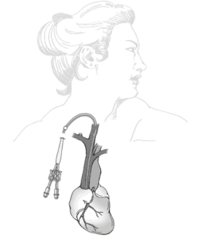

A dialysis catheter is a catheter used for exchanging blood to and from a hemodialysis machine and a patient.
The dialysis catheter contains two lumens: venous and arterial. Although both lumens are in the vein, the "arterial" lumen, like natural arteries, carries blood away from the heart, while the "venous" lumen returns blood towards the heart. The arterial lumen (typically red) withdraws blood from the patient and carries it to the dialysis machine, while the venous lumen (typically blue) returns blood to the patient (from the dialysis machine). Flow rates of dialysis catheters range between 200 and 500 ml/min.
If a patient requires long-term dialysis therapy, a chronic dialysis catheter will be inserted. Chronic catheters contain a dacron cuff that is tunneled beneath the skin approximately 3–8 cm. The tunnel is thought to add a barrier to infection. The most popular dialysis catheter sold on the market today is the Symmetrical-Tip dialysis catheter. This catheter is in the form spiral Z shape.

Types
Temporary access
Central venous catheters intended for temporary access (sin. Quinton catheters) are typically used for less than 21 days. These types of catheters are usually smaller in size, placed directly in the vein, and are two or three lumens in design. The third lumen is useful for administration of fluids, antibiotics, medicines, or contrast without having to find other places for intravenous access. This type of catheter is useful for initiating venous access for acute renal failure patients quickly for dialysis before a permanent catheter is inserted for long term access.
Permanent access
The lumens of this type of catheter is larger, have a cuff that tunnel under the skin away from the venous insertion site with only two lumens. The catheter course under the skin helps to prevent infection going into bloodstream, as seen in temporary catheters.
Catheter placement
Common site of catheter placement is placed by puncturing the right internal jugular vein (IJV) in the neck, advancing into superior vena cava (SVC) towards the right atrium of the heart due to its straightforward path into the SVC. Alternatively, a SVC catheter can be inserted via the right external jugular vein (EJV) if right IJV is inaccessible. If both IJV and EJV are both not accessible, left IJV can be assessed. However, left IJV access is more difficult that right IJV because of its tortuous course to the SVC.
Complications
Some common malfunctions of dialysis catheters include clotting, infection, and kinking. One of the most common errors of tunnel hemodialysis catheter insertions is failure to locate the arterial limb of the catheter medially and the venous limb laterally. This must be done, because most catheters have a memory in the plastic, which will cause the catheter to try to resume its natural straight form. If the arterial limb is placed laterally, this will cause the arterial inlet to float up against the vein wall, or even up against the rim of the inlet of the atrium. This has the same effect as a vacuum cleaner hose sucking up against curtains. This results in poor blood flows, and can force the dialysis staff to reverse flow, using the venous limb of the catheter as the arterial. This will result in more inefficient dialysis, as there will be admixing of blood from the catheter (cleaning the same blood, over again). A dialysis catheter must have infusion of 30cc or greater to keep the line open. Intravenous fluids at 30ml per hour should be hung if being used for infusion.
Fistulas versus catheters
Surgically created arteriovenous fistulae are preferred over catheters for patients with chronic kidney failure, as the risk of infections (e.g., endocarditis, bacteremia), hospitalization and death are lower.
References
- ^ Bream PR (March 2016). "Update on Insertion and Complications of Central Venous Catheters for Hemodialysis". Seminars in Interventional Radiology. 33 (1): 31–38. doi:10.1055/s-0036-1572547. PMC 4803506. PMID 27011425.
- Huijbregts HJ, Blankestijn PJ (March 2006). "Dialysis access--guidelines for current practice". European Journal of Vascular and Endovascular Surgery. 31 (3): 284–7. doi:10.1016/j.ejvs.2005.12.004. PMID 16500586.
- McGill RL, Marcus RJ, Healy DA, Brouwer DJ, Smith BC, Sandroni SE (2005). "AV fistula rates: changing the culture of vascular access". The Journal of Vascular Access. 6 (1): 13–7. doi:10.1177/112972980500600104. PMID 16552677.
- Allon M, Daugirdas J, Depner TA, Greene T, Ornt D, Schwab SJ (March 2006). "Effect of change in vascular access on patient mortality in hemodialysis patients". American Journal of Kidney Diseases. 47 (3): 469–77. doi:10.1053/j.ajkd.2005.11.023. PMID 16490626.
External links
 Media related to Dialysis catheter at Wikimedia Commons
Media related to Dialysis catheter at Wikimedia Commons
| Intravenous therapy | |||||||||||||||
|---|---|---|---|---|---|---|---|---|---|---|---|---|---|---|---|
| Infused substances |
| ||||||||||||||
| Access points | |||||||||||||||
| Other equipment | |||||||||||||||
| Specific risks | |||||||||||||||
| See also | |||||||||||||||